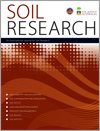The market for novel biobased fertilisers is growing, but little is known about how they affect soil quality in the long term. In a one-year laboratory incubation experiment, this study aimed to test the effect on selected soil quality indicators of 10 biobased fertilisers, which were found to improve soil quality overall, with a compost material being the most effective. The results help to understand how different biobased fertilisers can affect soil quality beyond their fertiliser value.
SR23213 Abstract | SR23213 Full Text | SR23213PDF (593 KB) | SR23213Supplementary Material (1.1 MB) Open Access Article





